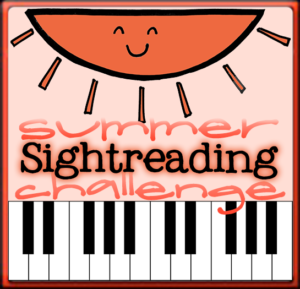Jenny Jones here. For the beginning of summer lessons, I wanted a fresh way to motivate my students to practice. Most were already in the habit of practicing everyday, though not always effectively. I felt like they were feeling in a rut, and I was feeling like I had lots of extra time on my hands, being done with school, and all. So I developed Points for Prizes.
How it works:
I made notebooks for each student with pages that look like this
and inserts that look like this (with room at the bottom for special student-specific points-earning activities)
Each week I have them keep track of what they practice each day, with the charts on the right of the assignments, as well as the number of minutes at the bottom (PI, in the notes section, is for parent initials

just to keep things honest).
When they come to their lessons, I have a chart for each student where I keep track of the points they’ve earned that week.
When they get to a hundred points, they get a sticker. When they get to 300 points, they start earning prizes.
The way I figured out the points and prizes began with what my expectations are for their practice. I expect them to practice everything everyday. That’s why that is worth so many points. I also want them to spend lots of time at the piano. I think a lot of my most valuable time at the piano was “goofing off”, not playing what I had already played, but learning new things by sight reading, picking out things by ear, etc. This way I’m rewarding both good practice and lots of it. Once I knew what I wanted every student to do every week, I started assigning point values to those assignments. I decided that 70 points a week was sufficient and sustainable (we can’t have them burning out).
Then I had to decide how much the prizes would be worth. This was trickier, and I’m still trying to figure some of them out. At first, I decided it would be by cost to me. I was willing to spend x amount per student per week if everybody was achieving those 70 points. But the challenge is that the older students are, the more expensive they are to motivate. I’m talking about the 10 to 12 year olds. Anyone older than that isn’t really interested. Plus, there comes a point when they need to be internally motivated. I’m trying to build solid practice habits now.
Things I think are working:
*Motivating younger students–the 5 to 9 year olds are eating this up.
*The expectation–I was happy to find out that many of my students already were doing some of these things. By spelling everything out like this, they are starting to prioritize they way I’d like them to prioritize (“oh, you mean, if I practice everything every day, I get a bonus of 30 points?!” “you mean, it’s not enough to just play the piano for 30 minutes every day?”).
*My instructions–I’m learning to be very specific in how they should practice, which is what I should have been doing all along. With some students it isn’t enough to say, “Learn this for this week.” I have to help them find the hard spots, make a plan for how to practice those sections differently, and then do some practicing in the lesson where we learn just how many times it takes them to get something solid. Since I am rewarding them for good practice, they want to know just what it takes to get the reward, so they are very interested in creating the plans for good practice. It’s kind of win-win.
Things that I still need to figure out:
*Motivating older students–one parent had a great solution. She said there was a toy that her son really wanted that they were willing to buy for him, but that he would earn it via this points system. So I sent her the points information and told her what my expectations are and then asked her to decide how many weeks of good practice she thought this toy was worth. Hopefully it helps him! The problem is that at this age, the kids are starting to be doing things by internal motivation, and then this amounts to bribery instead of incentive. If they really don’t want to practice, they won’t.
*Group prizes–I want to have a pizza party at the end of the summer. At first, I was going to have it for everyone who got x or more points. But I didn’t want to exclude anyone, especially the very young kids who aren’t practicing that much anyway. So then I decided that I’d do a group effort. If, as a group, we get x points, then we can have a pizza party. But I’m not sure what a reasonable number is at this point. This could be effective for kicking in some urgency. I will have a poster that shows how close we are to the number of needed points. If, come the beginning of August, we’re not on target, then I know at least a few of them will start some crazy practicing in order to push the numbers up.
*Long-term effects–I don’t like a lawyerly kind of “payment” for practice. Also, I don’t know how to insert a bit of new excitement into the program every semester or so. Maybe new prizes showcased every few months. Or a twist that involves some group lessons and the attendant activities. Ideas?





























































